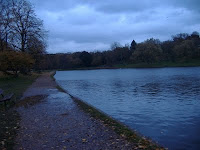HAMPSTEAD
 |
| Hampstead Heath |
Within the hour, the sign flashed “Hampstead”. By this point, we were few on the train. I had now achieved almost absolute exhaustion, a condition not alleviated by the professor telling me I was about to ascend from the deepest station in the whole city. But when at last I emerged, the scene was like nothing else.
Sunlight.
It had miraculously broken through the English shroud, and bathed everything in loveliness. A more concentrated look, and I beheld a swelling village sidewalk. Around us bloomed rows of tiny, crowded storefront facades, painted in various bright colors that almost hurt my eyes. Some bore pretty striped awnings. And everywhere, people went casually about their errands, chatting with tradesmen and carrying their shopping. One woman toted a flower bunch, wrapped in mint-hued paper, and I was passed by a small boy who reeked naughtily of caramel and cherry candy.
 |
| Parliament Hill 2006 |
It was such a simple thing, and yet I felt overwhelmed. I might have easily collapsed, had the professor not driven me on.
“The postmaster, Fräulein.”
Yes, of course.
“So, this you see is Hampstead," he started out, breaking off to excuse himself to a pedestrian for the inconvenience of my suitcase. “If it looks like a village, it’s because it was once a rural retreat, with parkland and spas for the wealthy. In 1889 it was then integrated into the London municipality.”
Another example of Professor Deisler’s didactic Ausführlichkeit. I was only sorry to make such a distracted and tired audience.
“We coped with our share during the Blitz,” he kept on, “but luckily, the main elements of its bucolic charm remain preserved. Of course, Hampstead can hardly claim to resemble the quaint farmland it was in Keat’s time.”
Another excused swing of my luggage.
“No fairy queens here, I’m afraid, even before the bombing. And Constable!” The professor’s voice billowed to an amused pitch, “if he stood in this place today, he’d be likely to turn about like a ninny, wondering where all the heifers went!”
The evocation of these former Hampstead residents apparently tickled him to no end, and he had several times to readjust his grip on my suitcase. For my part, I basked in the sound of beautiful names like Keats and Constable. Being that I hadn’t heard anyone mention artists and writers in such a painfully long time. And I was especially glad Professor Deisler credited me enough education to not bother elucidating further on them. In that respect, at least, I was my parent’s daughter. Page 22-23
Oh, Hampstead...that bucolic London suburb, home to British artists and writers for close to two hundred years. Among them some of my very favorite names, like John Constable, Charles Dickens, Lord Byron, T.S. Eliot, Agatha Christie, and George Orwell. I would give my right arm to own even a 50sf broom closet in this "suburban Nirvana" that is apparently home to the wealthiest people in the UK.
 |
| Hampstead Heath with a rainbow (1836) by John Constable |
But I had more specific considerations in choosing this neighborhood as the backdrop for GIBBIN HOUSE - namely its history of attracting European exiles in the early 20th Century. Sigmund Freud settled here, as did Ernst Gombrich, Walter Gropius, Lucian Freud, Hans Heller, etc. It didn't seem entirely implausible that a safehouse might have existed in this bohemian enclave, a combination of Anna Segher's rundown Riviera digs in 'Transit' and Doris Lessing's East End basement flat, with an element of Rick's Place thrown in...I suppose safehouses are usually set up in more inconspicuous, urban sort of areas. I could have gone the opposite route and picked a tenament in Stockwell. But who are we kidding? I am way to sentimental and fanciful for that. I wanted to afford my characters the luxury I would never have of finding themselves tucked away in the charming neverland that inspired Keat's "Endymion".
 |
| John Keat's House in Hampstead (Qwiki) |
But luckily nature does not change as fast, and when I visited Hampstead Heath in November of 2006, I witnessed the same brooding skies and experienced the same fierce winds Anka would have fifty years earlier. In that sense, it seemed the heath offered the perfect bridge between the past and the present, a massively verdant and poetic constant inthe midst of our capricious tendencies and ever-shifting cityscapes.
It was going on past sunset when Theodor finally started his way back to Gibbin House. From his park bench on Parliament Hill he had until now sat watching entire London sink into a purple moor. Darkness already enveloped him from behind, where across the northern portions of the heath stretched impenetrable layers of black wood. Over the village alone the sky still glimmered orange.
Theodor was reluctant to return. He didn’t want to cling to day, to the warm illusion of those last washes of light. He wanted to drown with the city, throw himself downhill into the damp grass and the brambly thickets.
Listlessly he rose and trekked the abandoned trails towards Spaniards Road. Occasionally he rolled his shoulders or scratched the bristly growth peppered on his jaw. Out here in the open he was very aware of his body, of every wheezing whistle in his nose as he inhaled the chilly air. He felt the prickle of wool on his legs and the slight rheumatic throbbing in his lower spine. Sniffling, arching his back, Theodor advanced along the winding footpaths, feeling himself cut quite the haggard figure against an ever-consuming dusk. Page 47



No comments:
Post a Comment